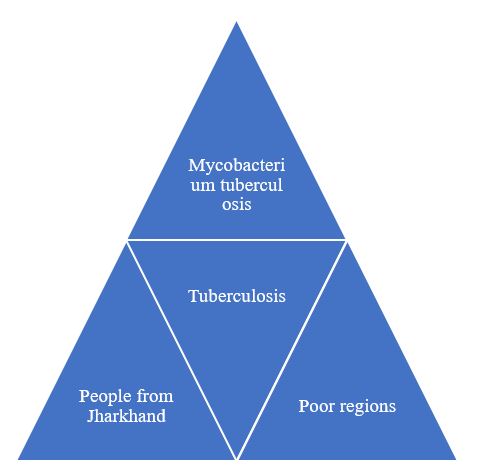Pat’s case of TB presupposes the agent, host, and the appropriate environment for the infection. The teacher has just visited poverty-stricken areas of Jharkhand, India, meaning she was exposed to risk factors, such as overcrowding and lack of vaccinated individuals.

People from these regions can be viewed as hosts, while poor areas with inappropriate conditions are the environment for the agent, mycobacterium tuberculosis (Adams & Messias, 2019). From the web of causality, Pat’s trip to India might cause infection and the development of the disease.

Global Implications
The increased global travel has resulted in the emergence of new challenges of epidemiology. People from various regions can spread infection faster and avoid natural barriers, which introduces additional risks. For instance, aviation transported people with coronavirus, which resulted in the COVID-19 pandemic, with about 176 million cases globally (CDC, 2021). However, better information sharing cultivates more effective disease control and enhances knowledge.
Health Data
Valid health data improves the management of the most relevant challenges and the choice of interventions to help people. For instance, the topical health problem is the growing smoking rates in the region. Possessing the relevant information about the primary causes impacting people’s motifs to start using tobacco, it is possible to create preventive and prophylactic measures to resolve the problem and reduce its current rates.
Sources of Data
The two possible sources of data are the website of the Virginia Department of Health and Centers for Disease Control and Prevention. These two sources offer relevant and credible information about smoking patterns in the area and causes leading to the emergence of new addicted people. For this reason, it is vital to use these sites to discuss the problem and ways to struggle with it.
Incidence and Prevalence
Prevalence means the proportion of people who have a certain condition in a certain period of time, while incidence shows the rate of new cases occurring in a specific population. Smoking rates in Virginia continue to grow, proving the need for intervention (“Extinguishing the tobacco epidemic in Virginia,” n.d.). The current statistics show that 39.9% of people have smoked at least 100 cigarettes in their life (VDH, n.d.). The Southwest regions are characterized by a prevalence rate of 18.1% (VDH, n.d.).
Levels of Prevention
The three levels of prevention include primary, secondary, and tertiary types. The first one tries to prevent the illness before it occurs, the second level focuses on reducing the impact of the disease, and the tertiary one aims to soften the effects of ongoing conditions. They are all applicable to the selected problem as it is vital to prevent new smoking cases and help to struggle with its impact. Nurse leaders should inform populations about current ways to quit.
Upstream Thinking
Upstream thinking means the ability to make wise and effective collective actions to guarantee better results and avoid serious problems or crises. Speaking about the selected concern, using this method, it is possible to reduce the growth in rates by a collective effort focused on minimization of incidence and improving people’s awareness. It will help to alter the current trends and attain desired goals.
Advocacy
Determinants of health are critical factors influencing people and their quality of life. For instance, a poor social environment and a lack of knowledge promote higher smoking rates. For this reason, a nurse should correctly realize these aspects and be ready to work with them to ensure that patients with specific characteristics are provided with the assistance needed to improve their conditions.
References
Adams, S. A., & Messias, D. K. H. (2019). Epidemiology. In M. Stanhope & J. Lancaster (Eds.), Public health nursing: Population-centered health care in the community (10th ed., pp. 269–298). Elsevier Mosby.
Centers for Disease Control and Prevention (CDC). (2021). Global COVID-19. Web.
Extinguishing the tobacco epidemic in Virginia. (n.d.). CDC. Web.
Virginia Department of Health (VDH). (n.d.). Virginia adult tobacco survey. Web.